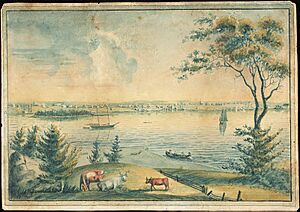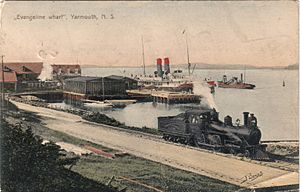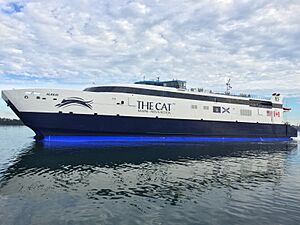Yarmouth, Nova Scotia facts for kids
Quick facts for kids
Yarmouth
|
|||
|---|---|---|---|
|
Town
|
|||
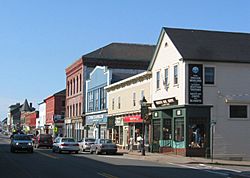
Main Street Yarmouth
|
|||
|
|||
| Nickname(s):
"The Gateway to Nova Scotia"
|
|||
| Motto(s):
"Progress"
"On the Edge of Everywhere" |
|||
| Country | Canada | ||
| Province | Nova Scotia | ||
| County | Yarmouth | ||
| Founded | June 9, 1761 | ||
| Incorporated | August 6, 1890 | ||
| Electoral Districts Federal |
West Nova |
||
| Provincial | Yarmouth | ||
| Government | |||
| • Type | Town Council | ||
| Area
(2021)
|
|||
| • Land | 10.57 km2 (4.08 sq mi) | ||
| • Population Centre | 16.81 km2 (6.49 sq mi) | ||
| Highest elevation | 43 m (141 ft) | ||
| Lowest elevation | 0 m (0 ft) | ||
| Population
(2021)
|
|||
| • Total | 6,829 | ||
| • Density | 646.3/km2 (1,674/sq mi) | ||
| • Population Centre | 7,848 | ||
| • Population Centre density | 466.8/km2 (1,209/sq mi) | ||
| Time zone | UTC−04:00 (AST) | ||
| • Summer (DST) | UTC−03:00 (ADT) | ||
| Postal code(s) |
B5A
|
||
| Area code | 902 & 782 | ||
| Highways | |||
| Dwellings | 3569 | ||
| Median Income* | $31,584 CDN | ||
| NTS Map | 20O16 Yarmouth | ||
| GNBC Code | CBPIB | ||
| Website | townofyarmouth.ca | ||
Yarmouth is a town located in the southwestern part of Nova Scotia, Canada. It's a busy port town, known for its fishing industry and for attracting visitors. Yarmouth is also where a ferry service to Bar Harbor, Maine starts, operated by Bay Ferries.
Contents
History of Yarmouth
The area where Yarmouth is now was first home to the Mi'kmaq people. They called the region "Keespongwitk," which means "Lands End." This name came from its location at the very tip of the Nova Scotia peninsula.
Early European Settlers
In 1604, Samuel de Champlain visited the region. He named it "Cap-Fourchu," meaning "forked or cloven cape." The first Europeans to settle here were the French Acadians. They started a small fishing village called "Tebouque" in the mid-1600s. By 1750, about 50 people lived there.
During the Seven Years' War, settlers from New England arrived. These "New England Planters" came to what is now Yarmouth in 1759. They were from Yarmouth, Massachusetts and asked for the new town to be named after their old home. Yarmouth was officially founded on June 9, 1761. The first ship arrived with three families from Sandwich, Massachusetts. These families were Sealed Landers, Ebenezer Ellis, and Moses Perry.
American Revolution Impact
During the American Revolution, some people in Yarmouth supported the American side. Even after American privateers attacked Yarmouth in 1775, locals still helped American prisoners. This happened after a sea battle near Yarmouth in 1777.
After the war, many United Empire Loyalists arrived in 1785. These were people who stayed loyal to Britain. Also, Acadians who had been forced to leave earlier returned in 1767. They settled in the Yarmouth area, coming from places like Grand-Pré, Nova Scotia.
Shipbuilding Era

Throughout the 1800s, Yarmouth became a very important place for shipbuilding. At one point, it had more registered ship tonnage per person than any other port in the world. From 1874 to 1885, Yarmouth was the second largest port in Canada for ship registration. Only Saint John, New Brunswick was larger.
In 1878, Yarmouth's ship tonnage reached its highest point. It had 453 vessels totaling 166,623 tons. Yarmouth ships sailed to major ports all over the world. Some ships were known for their brave crews, like the Research in 1861. Others were famous for their huge size, such as the County of Yarmouth in 1884. This was one of the biggest wooden ships ever built in Canada.
John Patch, whose father was a Yarmouth sea captain, invented an early modern screw propeller. He built it in 1832, four years before John Ericsson got his patent. Patch showed his propeller in Yarmouth Harbour in 1833. He didn't get a patent that year but kept improving his design. He finally received an American patent in 1849. Even though his work was praised, many other screw propellers existed by then. John Patch never became rich or famous and died poor in Yarmouth in 1861.
The town of Yarmouth officially became a town on August 6, 1890.
Railways and Connections
As wooden shipbuilding slowed down, Yarmouth's ship owners invested in new things. They put their money into factories, iron steamships, and railways. The first railway in town was the Western Counties Railway. It ran from Yarmouth to Digby in the 1870s. This railway later joined the Dominion Atlantic Railway (DAR). The DAR connected Yarmouth to the Annapolis Valley, Halifax, and Truro. It eventually became part of the Canadian Pacific Railway (CPR).
Another railway, the Halifax and South Western Railway, was built along the south shore. It linked Yarmouth with Shelburne, Liverpool, Bridgewater, and Halifax. This happened in the early 1900s. This railway later became part of the Canadian National Railway (CNR).
Even though iron steamships led to the end of wooden shipbuilding, they made Yarmouth important. The port became a key link between Nova Scotia's railways and steamships going to Boston and New York. Train services to Yarmouth stopped in stages, from 1982 (CNR) to 1990 (CPR).
Steamships and Ferries
Tourism became a big industry in Yarmouth starting in the 1880s. This was when Loran Ellis Baker started the Yarmouth Steamship Company. His company and the railways helped create the first tourism marketing in Nova Scotia. Baker's steamships sailed between Yarmouth and Boston until 1900. Then, the Dominion Atlantic Railway bought his company.
The DAR and the Halifax and South Western Railway offered connections for passengers. People arriving in Yarmouth could take steamships to New York City and Boston. In 1939, a woman named Molly Kool made history in Yarmouth. She became the first female ship captain in the Western World.
Steamship services between Yarmouth and Boston/New York stopped during World War II. The SS Yarmouth Castle was one of the ships on this route. The service started again a few years after the war with the S.S. Yarmouth. This continued until the mid-1950s, when the M.V. Bluenose replaced it.
Modern Ferry Services
After the war, people in western Nova Scotia wanted a daily ferry service. This was needed to move goods and passengers between Nova Scotia and the United States. In 1954, the government built the MV Bluenose. It started service in 1956, managed by Canadian National Railway (CNR). Later, it was managed by CN Marine.
In 1978, CN Marine added the MV Marine Evangeline for a service to Portland, Maine. The original Bluenose was retired in 1982. A new vessel, the MV Stena Jutlandica, was renamed MV Bluenose to avoid confusion.
In 1997, the government stopped funding the ferry service. They asked private companies to take over.
The Cat Ferry Service
In 1997, Bay Ferries won the bid to operate the ferry service. They bought the MV Bluenose and later introduced a high-speed catamaran. This was the first high-speed passenger-vehicle ferry service in North America. It was called "The Cat." The idea was to make the trip faster to keep people using the ferry.
In 2002, Bay Ferries got a larger "Cat" vessel. From 2006, "The Cat" also sailed to Portland, Maine. However, due to fewer American tourists and high fuel prices, Bay Ferries asked for government help. The service ended in 2009 when the government stopped its funding.
Nova Star and Return of The Cat
In 2013, the provincial government looked for a new ferry operator. Nova Star Cruises was chosen and started service in May 2014 with the MV Nova Star. It offered daily trips between Yarmouth and Portland. However, Nova Star's contract was not renewed for 2016.
On March 24, 2016, Bay Ferries Limited announced that "The Cat" would return. They leased a new high-speed vessel, HST-2, and rebranded it as The CAT. The service between Portland, Maine, and Yarmouth began on June 15, 2016.
Yarmouth in World War II
During the early part of World War II, Yarmouth became an important training location. It hosted a British Commonwealth Air Training Plan (BCATP) facility. RCAF Station Yarmouth opened in 1940 with three training sites.
One site trained bomber crews for the Royal Air Force. Another site was home to Royal Canadian Air Force (RCAF) squadrons. These squadrons flew planes to find and attack submarines. The main air base provided support for these squadrons. It also had a weather station and a firing range.
On July 31, 1942, an RCAF Lockheed Hudson bomber from Yarmouth made history. It was the first aircraft from RCAF Eastern Air Command to sink a submarine. It destroyed the U-754 about 100 miles south of Yarmouth. All 43 people on the submarine were lost.
Smaller military sites were also set up around Yarmouth. These included a bombing range and radar stations. In 1944, the United States Navy briefly tested blimps in Yarmouth. After a crash, the RCAF decided not to use them.
RCAF Station Yarmouth closed in 1945. The airfield was sold in 1946 and became the Yarmouth Airport. A Canadian Army training camp in Yarmouth also trained 20,000 soldiers during the war.
Culture and Arts
Yarmouth is a center for arts and culture. The Western Branch of the Art Gallery of Nova Scotia is located here. The town also has the Yarmouth County Museum & Archives. This museum keeps the history of the town and county alive. It also runs the historic Killam Brothers building on the waterfront.
The Firefighters Museum of Nova Scotia is on Main Street. It is part of the Nova Scotia Museum system. There is also a private museum called the Sweeney Fisheries Museum.
The Izaak Walton Killam Memorial house became the town's public library in 1963. It is the largest branch of the Western Counties Regional Library. The regional library's main office is also located here.
The Yarmouth Arts Regional Council was started in 1974 by Lydia Davison, a music teacher. With help from the Canada Council and many volunteers, the Yarmouth Arts Regional Centre (Th'YARC) was built. It has a 350-seat theater, an art gallery, and a print-making shop. Th'YARC is still active today.
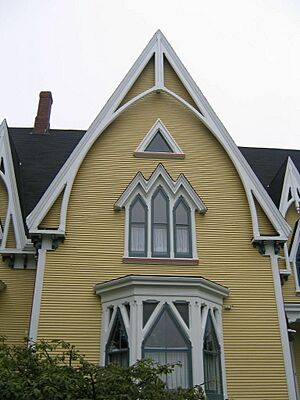
Many people in Yarmouth believe that the famous American composer Meredith Willson wrote his song "It's Beginning to Look a Lot Like Christmas" while staying at Yarmouth's Grand Hotel. This is a popular local story.
In August 2004, a very large mako shark was caught near Yarmouth. It weighed 1,082 pounds during the Yarmouth Shark Scramble. This set a new Canadian record and is one of the largest mako sharks ever caught.
Seafest is a popular annual festival in Yarmouth. It lasts for seven days and has been organized since 1979.
Buildings and Architecture
Yarmouth is famous for its beautiful Victorian houses. These homes show the wealth of the ship captains and owners from the town's "Golden Age" of seafaring. A special heritage district protects several blocks of these old homes. Examples include the Lovitt House and the Eakin/Hatfield House.
On the waterfront, two old warehouses from the sailing era still stand. These are the Killam Brothers and Parker-Eakin's buildings. Each has a wharf and they are central to summer events by the water.
Yarmouth's Main Street has several unique Victorian commercial buildings. One example is the Yarmouth Block Building with its turret. The largest building in town is the Rodd Grand Hotel, built in the 1970s. It stands where the original Grand Hotel, a landmark for many years, once was.
A well-known landmark for Yarmouth Harbour is the large Cape Forchu Lighthouse. It is a few kilometers away at Cape Forchu. This peninsula protects Yarmouth Harbour. The tall "apple core" style of the lighthouse is a great example of modernist design.
Climate and Weather
| Weather chart for Yarmouth | |||||||||||||||||||||||||||||||||||||||||||||||
|---|---|---|---|---|---|---|---|---|---|---|---|---|---|---|---|---|---|---|---|---|---|---|---|---|---|---|---|---|---|---|---|---|---|---|---|---|---|---|---|---|---|---|---|---|---|---|---|
| J | F | M | A | M | J | J | A | S | O | N | D | ||||||||||||||||||||||||||||||||||||
|
124
1
-6
|
103
1
-6
|
111
4
-3
|
101
9
1
|
99
14
6
|
89
18
10
|
78
21
13
|
88
22
13
|
96
19
11
|
119
14
6
|
143
9
2
|
139
4
-3
|
||||||||||||||||||||||||||||||||||||
| temperatures in °C precipitation totals in mm source: Environment and Climate Change Canada |
|||||||||||||||||||||||||||||||||||||||||||||||
|
Imperial conversion
|
|||||||||||||||||||||||||||||||||||||||||||||||
Yarmouth has a humid continental climate. This means it has four distinct seasons. It is also very close to an oceanic climate, which is common for places near the sea but close to large landmasses.
Winters in Yarmouth are cool and rainy. The average temperature in January is about -2.6°C. Because it's near the ocean, temperatures rarely drop below -20°C. The average high temperature never falls below freezing. Winter weather can be cloudy and unsettled due to storms called "Nor'easters." Yarmouth gets about 204.7 cm of snow each year. Its winters are among the mildest in Canada east of the Rocky Mountains.
Summers in Yarmouth are cool because of the strong ocean influence. Temperatures rarely go above 30°C. The warmest month is August, with an average temperature of 17.5°C. Fall is warmer than spring because the ocean water is at its warmest then. Spring is cooler because the water is still cold.
Yarmouth gets a lot of rain, averaging 1290.1 mm per year. July and August are usually the driest months. November is typically the wettest. Yarmouth often has more rain and snow from late fall to early winter. This is because of strong storms during that time. Thunderstorms are less common here than in the northeastern U.S.
Yarmouth gets about 1,898.3 hours of sunshine each year. Summer is the sunniest season, and winter is the cloudiest. Yarmouth also experiences about 191 days of fog every year.
The highest temperature ever recorded in Yarmouth was 32.5°C on July 16, 2013. The coldest temperature ever recorded was -24.4°C on February 14, 1894.
| Climate data for Yarmouth (Yarmouth Airport) WMO ID: 71603; coordinates 43°49′37″N 66°05′17″W / 43.82694°N 66.08806°W; elevation: 42.9 m (141 ft); 1991–2020 normals, extremes 1870−present |
|||||||||||||
|---|---|---|---|---|---|---|---|---|---|---|---|---|---|
| Month | Jan | Feb | Mar | Apr | May | Jun | Jul | Aug | Sep | Oct | Nov | Dec | Year |
| Record high humidex | 15.8 | 16.9 | 17.4 | 24.8 | 27.9 | 34.5 | 37.7 | 37.3 | 36.4 | 30.2 | 26.1 | 19.5 | 37.7 |
| Record high °C (°F) | 14.0 (57.2) |
15.3 (59.5) |
18.3 (64.9) |
21.2 (70.2) |
24.8 (76.6) |
27.4 (81.3) |
32.5 (90.5) |
30.3 (86.5) |
27.7 (81.9) |
22.8 (73.0) |
19.3 (66.7) |
16.5 (61.7) |
32.5 (90.5) |
| Mean daily maximum °C (°F) | 1.3 (34.3) |
1.3 (34.3) |
4.0 (39.2) |
8.8 (47.8) |
13.9 (57.0) |
18.1 (64.6) |
21.4 (70.5) |
21.6 (70.9) |
18.8 (65.8) |
13.6 (56.5) |
9.0 (48.2) |
4.4 (39.9) |
11.4 (52.5) |
| Daily mean °C (°F) | −2.6 (27.3) |
−2.5 (27.5) |
0.4 (32.7) |
5.0 (41.0) |
9.8 (49.6) |
14.0 (57.2) |
17.3 (63.1) |
17.5 (63.5) |
14.7 (58.5) |
9.8 (49.6) |
5.5 (41.9) |
0.8 (33.4) |
7.5 (45.5) |
| Mean daily minimum °C (°F) | −6.4 (20.5) |
−6.2 (20.8) |
−3.3 (26.1) |
1.2 (34.2) |
5.7 (42.3) |
9.8 (49.6) |
13.2 (55.8) |
13.4 (56.1) |
10.5 (50.9) |
6.1 (43.0) |
1.9 (35.4) |
−2.9 (26.8) |
3.6 (38.5) |
| Record low °C (°F) | −21.3 (−6.3) |
−24.4 (−11.9) |
−15.7 (3.7) |
−10.8 (12.6) |
−1.8 (28.8) |
2.1 (35.8) |
6.4 (43.5) |
5.8 (42.4) |
1.3 (34.3) |
−3.2 (26.2) |
−9.8 (14.4) |
−16.6 (2.1) |
−24.4 (−11.9) |
| Record low wind chill | −32.6 | −32.0 | −28.5 | −22.5 | −4.3 | 0.0 | 0.0 | 0.0 | 0.0 | −6.9 | −19.5 | −28.2 | −32.6 |
| Average precipitation mm (inches) | 123.6 (4.87) |
102.8 (4.05) |
110.7 (4.36) |
101.4 (3.99) |
99.1 (3.90) |
88.7 (3.49) |
78.0 (3.07) |
88.1 (3.47) |
95.9 (3.78) |
119.3 (4.70) |
143.4 (5.65) |
139.1 (5.48) |
1,290.1 (50.79) |
| Average rainfall mm (inches) | 69.1 (2.72) |
60.0 (2.36) |
82.5 (3.25) |
92.7 (3.65) |
98.5 (3.88) |
88.9 (3.50) |
81.8 (3.22) |
89.8 (3.54) |
97.5 (3.84) |
124.1 (4.89) |
133.8 (5.27) |
97.8 (3.85) |
1,116.5 (43.96) |
| Average snowfall cm (inches) | 63.6 (25.0) |
46.5 (18.3) |
30.8 (12.1) |
9.5 (3.7) |
0.2 (0.1) |
0.0 (0.0) |
0.0 (0.0) |
0.0 (0.0) |
0.0 (0.0) |
0.4 (0.2) |
10.0 (3.9) |
43.7 (17.2) |
204.7 (80.6) |
| Average precipitation days (≥ 0.2 mm) | 20.5 | 16.4 | 14.9 | 13.9 | 13.4 | 11.6 | 9.9 | 9.8 | 10.1 | 12.1 | 15.1 | 19.7 | 167.2 |
| Average rainy days (≥ 0.2 mm) | 8.5 | 7.0 | 8.8 | 12.3 | 13.3 | 11.5 | 10.2 | 9.7 | 10.4 | 11.8 | 13.4 | 12.2 | 128.9 |
| Average snowy days (≥ 0.2 cm) | 15.5 | 12.0 | 9.0 | 3.1 | 0.1 | 0.0 | 0.0 | 0.0 | 0.0 | 0.2 | 3.1 | 10.2 | 53.2 |
| Average relative humidity (%) (at 15:00 LST) | 77.8 | 74.1 | 70.3 | 70.3 | 73.4 | 76.7 | 78.7 | 77.1 | 75.4 | 73.0 | 74.5 | 77.3 | 74.9 |
| Mean monthly sunshine hours | 76.0 | 103.5 | 141.6 | 178.8 | 213.0 | 217.6 | 227.6 | 220.0 | 186.8 | 165.6 | 97.6 | 70.3 | 1,898.3 |
| Percent possible sunshine | 26.3 | 35.0 | 38.4 | 44.4 | 46.7 | 47.1 | 48.6 | 50.8 | 49.6 | 48.4 | 33.5 | 25.3 | 41.2 |
| Source: Environment and Climate Change Canada (extreme minimum February 1894) (sun from 1981-2010) | |||||||||||||
Population and People
| Historical population | ||
|---|---|---|
| Year | Pop. | ±% |
| 1762 | 100 | — |
| 1871 | 4,696 | +4596.0% |
| 1881 | 5,324 | +13.4% |
| 1889 | 5,818 | +9.3% |
| 1891 | 6,089 | +4.7% |
| 1901 | 6,430 | +5.6% |
| 1911 | 6,600 | +2.6% |
| 1921 | 7,073 | +7.2% |
| 1931 | 7,055 | −0.3% |
| 1941 | 7,790 | +10.4% |
| 1951 | 8,106 | +4.1% |
| 1956 | 8,095 | −0.1% |
| 1961 | 8,636 | +6.7% |
| 1966 | 8,319 | −3.7% |
| 1971 | 8,519 | +2.4% |
| 1976 | 7,801 | −8.4% |
| 1981 | 7,475 | −4.2% |
| 1986 | 7,617 | +1.9% |
| 1991 | 7,781 | +2.2% |
| 1996 | 7,568 | −2.7% |
| 2001 | 7,561 | −0.1% |
| 2006 | 7,162 | −5.3% |
| 2011 | 6,761 | −5.6% |
| 2016 | 6,518 | −3.6% |
| 2021 | 6,829 | +4.8% |
In 2021, the population of Yarmouth was 6,829 people. These people lived in 3,259 homes. This was a 4.8% increase from its 2016 population of 6,518. The town covers a land area of 10.57 square kilometers. This means there were about 646.3 people per square kilometer in 2021.
|
|
|
|
|
|
Notable People from Yarmouth
- Sara Corning (1872–1969), a humanitarian and nurse during the Greco-Turkish War (1919–1922). She also founded an orphanage.
- Ryan Graves, a professional hockey player.
- Keith R. Porter (1912–1997), a pioneer in using electron microscopes for biology. He was born in Yarmouth.
Yarmouth in Media
Yarmouth was featured in the 2014 video game Assassin's Creed Rogue. The game takes place during the French and Indian War and the Seven Years' War. Players can explore Yarmouth as a location in the game.
|
See also
 In Spanish: Yarmouth para niños
In Spanish: Yarmouth para niños





